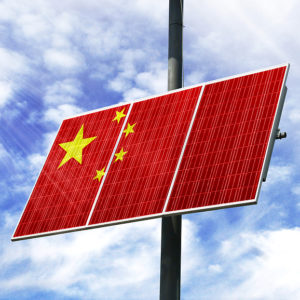Imagine this: The U.S., once dependent on foreign oil to power its cars, trucks and airplanes, is now more independent than it’s been in a generation.
No longer reliant on OPEC and our Canadian friends, we turn to alternative sources of power as climate change fears force our hands.
Solar wins the day. Only, instead of being dependent on foreign oil, we become dependent on solar panels made elsewhere. If there is ever a Green New Deal that doesn’t specify a preference for Made in America solar, it’s going to be a “Red New Deal” made in China.
Barring the advent of long-life batteries like the kind Tesla is developing, solar looks set to be the future. Sourcing solar panels will be as important as sourcing crude oil. A McKinsey & Company global energy report says solar will be the leading source of energy generation by 2035. More than natural gas.
Solar is such a big deal, that even the guy who took us out of the Paris Accord and gets the stink eye from the likes of climate crusader Greta Thunberg — President Trump himself — signed a proclamation on October 10 further protecting the industry from low-cost Chinese panels that have been flooding the market.
China is not really worried about turning a profit on its solar panels. It is interested in being the dominant market force and keeping production in China. It’s in their national interest. Of the 10 top solar panel manufacturers in the world, eight of them are Chinese. Only one is American: First Solar. They make solar modules in Perrysburg, Ohio, a place some might call “fly-over country.”
Solar importers hate the idea of Trump’s quotas and 18 percent tariff rate. They vowed to fight it just days after the White House proclamation.
Which brings us back to the Green New Deal.
Biden’s climate plan — which he refers to as a Clean Energy Revolution uses the Green New Deal as a “crucial framework.” Biden wants to install 500 million solar modules in five years. But where will they come from? This should be important to anyone who cares about energy security, and American manufacturing jobs, as Biden is now touting in his climate friendly “Build Back Better” presidency.
Since the Obama years, China has been clued in on the Western World’s climate fears. It’s been building up its green tech sector for at least a decade now.
In 2017, Suniva and SolarWorld complained to Washington about China dumping heavily subsidized and underpriced solar products in the U.S. Both companies are no longer operational. It was impossible to compete against a flood of China products, among other matters.
A year later, tariffs on solar went global.
It didn’t matter where they were coming from. In response, American companies are now expanding. They can invest in innovation because they are less worried about being blown up by China.
At least four new factories were under construction a year after the tariffs took effect, with a combined capacity of 3.8 gigawatts. We now have more than 7 gigawatts of active solar panel production capacity, up from just one gigawatt in 2017. Industry estimates are that around 20 percent — on the high end — of solar panels installed in the U.S. were made here. In 2017, it was close to zero.
The fossil fuels industry has a lousy long-term outlook.
The solar industry is hiring and although the sun is free, the machinery that’s collecting its rays is not. If Biden goes doorbuster on solar to protect the climate, he will have to come up with a way to protect American innovation and solar industry labor too. Otherwise, we’ll go from dependence on foreign oil to dependence on foreign tech to power our economy.
You’d have to rename this thing the Red New Deal. It’d be more accurate.

